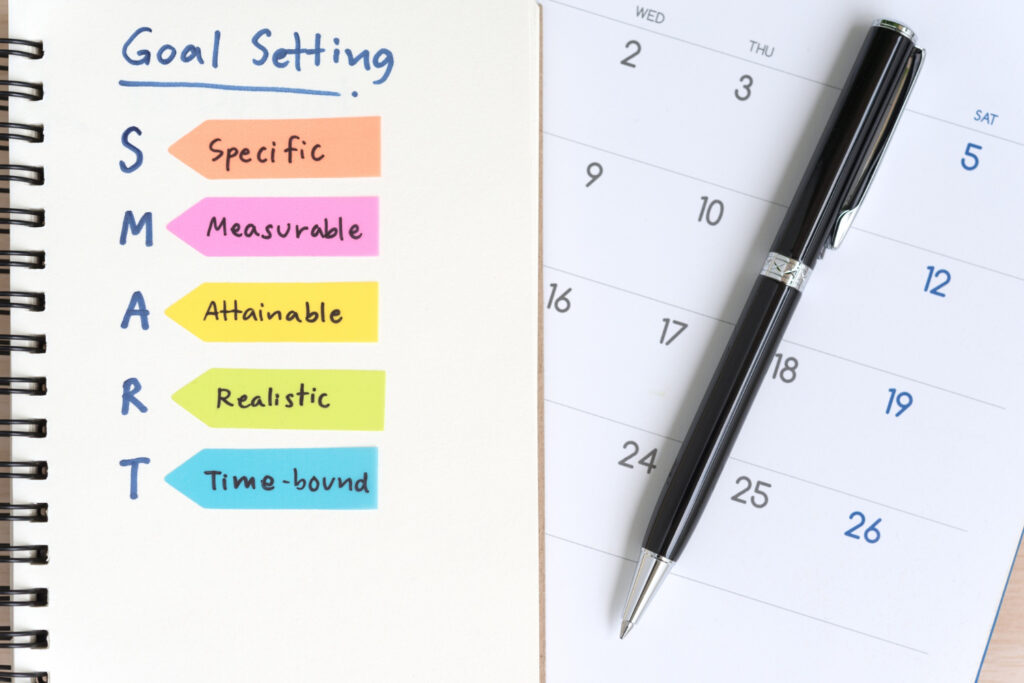The Education Blog

How to Set SMART Learning Goals for Personal Development
In today’s busy world, self-learning and personal growth matter more than ever. So, setting good learning goals is key. No matter if you’re a student, a professional aiming to improve, or someone eager for personal growth, knowing how to set learning goals can boost your journey. This blog explores SMART goal-setting for education. It shares effective strategies for self-improvement. By the end of this article, you’ll have the tools to set realistic goals. These goals will help you move toward success.
Key Benefits of SMART Goal-Setting for Education

Specific
Specific goals provide clarity and focus. Instead of saying, “I want to learn French,” be specific. “I want to be conversationally fluent in French by practising for 30 minutes each day.” This clear goal guides my efforts and resources well.
Measurable
Measurable goals allow you to track progress and stay motivated. Set benchmarks like taking a language level test every three months. This way, you can see how you’re doing and change your strategies if needed.
Achievable
Setting achievable goals makes sure they fit your current situation and resources. While ambition is vital, setting unattainable goals can lead to frustration and demotivation. Learning French in a month is likely unrealistic for most people. However, becoming conversationally fluent in a year is much more achievable.
Relevant
Goals should align with your broader personal or professional aspirations. If learning French helps your career or personal goals, it becomes more relevant. This makes you more committed to reaching that goal.
Time-bound
Time-bound goals have a deadline, creating a sense of urgency and focus. This aspect of SMART goals helps prevent procrastination and keeps you on track. For instance, aiming to pass a French test by year-end gives you a clear timeline for your learning.
Step-by-Step Guide to Setting SMART Learning Goals
Step 1: Define Your Learning Objective
The first step in setting SMART learning goals is to define what you want to achieve. Think about your personal or work goals. Find ways learning can help you grow. Ask yourself questions like:
- What skills or knowledge do I need to acquire?
- How will this learning benefit my personal or professional life?
- What motivates me to pursue this learning goal?
For instance, if you want to boost your career, you could learn a new programming language or get a certification in your area.
Step 2: Make Your Goal Specific
Once you’ve identified your learning objective, make it specific. Break down your goal into clear, concise statements that outline exactly what you aim to achieve. Use action verbs and avoid vague language.
Step 3: Establish Measurable Criteria
To ensure your goal is measurable, define criteria that allow you to track your progress. Consider quantitative measures, such as test scores, completed projects, or time spent practising.
Continuing with the public speaking example, you might measure progress by:
- The number of presentations delivered.
- Feedback received from peers.
- Improvements in audience engagement scores.
Step 4: Assess Achievability
Evaluate whether your goal is achievable given your current resources, time, and skills. Consider potential obstacles and how you might overcome them. This step is crucial for maintaining motivation and avoiding burnout.
If your goal is to give a presentation, make sure you have resources. This could be public speaking courses, mentors, or chances to practise.
Step 5: Ensure Relevance
Your learning goal should be relevant to your broader life goals. Reflect on how achieving this goal will contribute to your personal or professional development. This relevance will sustain your motivation throughout the learning process.
If your goal is to improve public speaking, consider how this skill will:
- Enhance your career prospects.
- Boost your confidence.
- Enable you to share your ideas more effectively.
Step 6: Set a Time Frame
Assign a deadline to your goal to create urgency and focus. Break the timeline into smaller milestones. This helps keep momentum and lets you celebrate progress as you go.
Set a deadline to deliver your presentation in three months. Also, set monthly milestones to practice in front of smaller groups or get feedback from a mentor.
Additional Expert Tips & Common Mistakes to Avoid

Expert Tips
- Write Down Your Goals: Writing down your goals increases commitment and accountability. It also serves as a constant reminder of what you’re working towards.
- Stay Flexible: While having a structured plan is essential, remain flexible. Life circumstances can change, and unexpected challenges may arise. Adjust your goals or timelines as needed without losing sight of your ultimate objective.
- Break Goals into Micro-Goals: To avoid feeling overwhelmed, split big goals into smaller, doable steps.
Common Mistakes to Avoid
- Setting Too Many Goals: Overloading yourself with too many goals can lead to burnout. Focus on a few key objectives that are most relevant to your development.
- Neglecting to Review and Reflect: Regularly reviewing your goals helps you stay on track. Assess your progress, celebrate milestones, and adjust strategies as needed.
- Lack of Specificity: Vague goals are difficult to achieve. Clearly define your objectives to make them actionable.
Advanced Insights & Expert Recommendations
1. Leverage Technology
Use technology to support your learning goals. Apps and platforms like:
- Trello for task management.
- Duolingo for language learning.
- Coursera or edX for online courses.
These tools help you track progress, stay organised, and access quality learning resources.
2. Seek Accountability Partners
Partnering with someone who shares similar learning goals boosts motivation and accountability.
- Join study groups.
- Participate in online forums.
- Find a mentor to share your progress and receive constructive feedback.
3. Embrace Lifelong Learning
Adopt a mindset of lifelong learning, where setting and achieving goals becomes a continuous process. Take on challenges, look for chances to grow, and stay open to learning new skills all through your life.
Unlock Your Potential: The Power of SMART Learning Goals for Personal Growth
Setting SMART learning goals is a powerful strategy for personal development and self-improvement. Follow the steps in this guide to set clear, achievable goals. These goals can lead to success and fulfilment. Remember to stay flexible, seek support, and embrace the journey of lifelong learning.
As you start your goal-setting journey, think about your dreams. Then, commit to taking real steps to achieve them. What learning goal will you set today to propel your personal development? The path to growth begins with a single step—the time to start is now.









